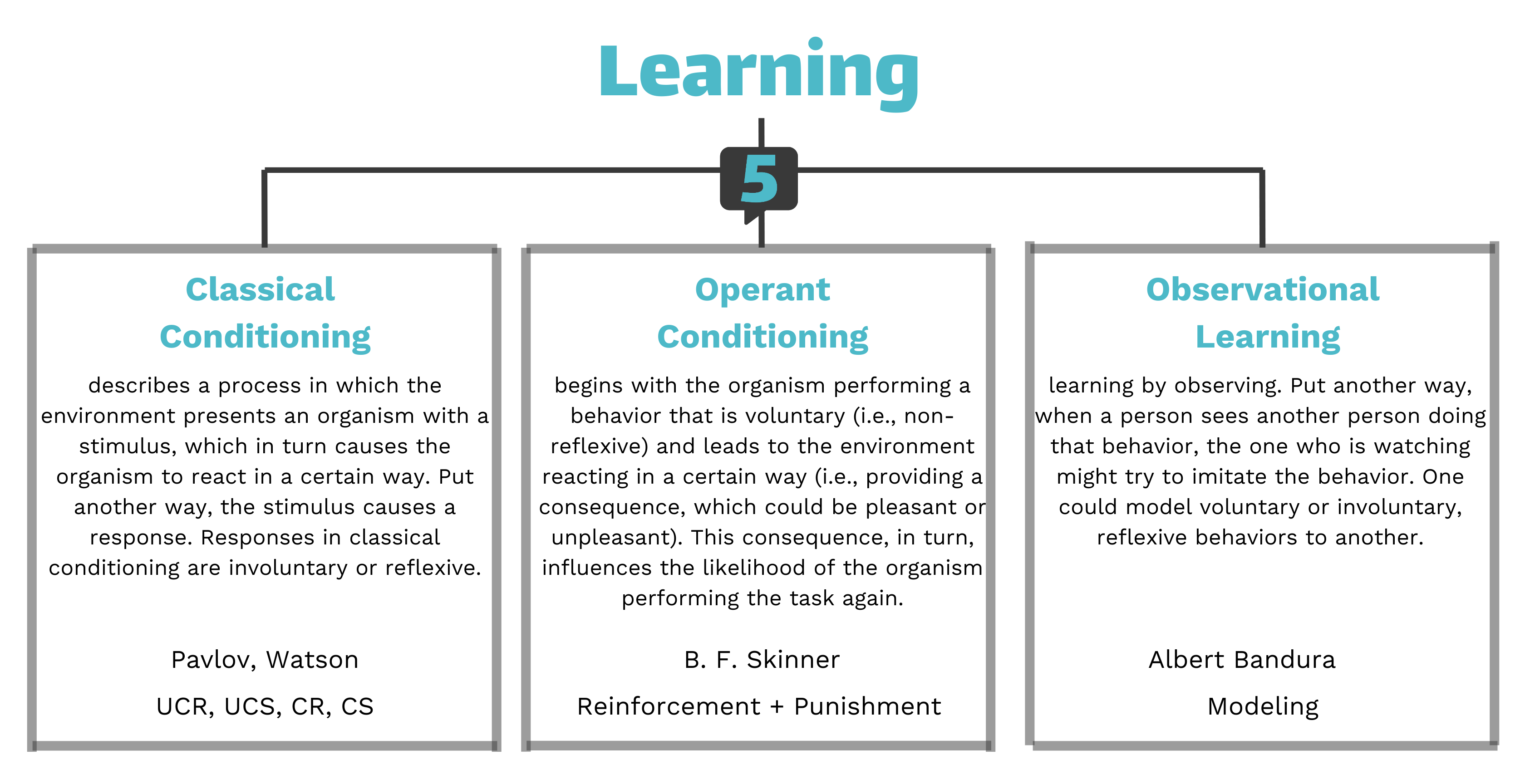John Mohl
Haseung Jun
Dalia Savy
AP Psychology 🧠
334 resourcesSee Units
Key Researchers
In the field of learning, there are a lot of people who make great processes in discovering new things about how we learn. Here are some of the most prominent names and the field of learning they were associated with - they're the ones that you might encounter on the AP exam. Just remember, you don't need to memorize anything, per se, but definitely have a general idea of who belongs in what learning category.
- Ivan Pavlov - classical conditioning
- John Watson - classical conditioning
- Edward Thorndike - operant conditioning
- Albert Bandura - observational learning
- Edward Tolman - latent learning
- Wolfgang Kohler - insight learning
- B.F. Skinner - operant conditioning
Three Types of Learning
The learning unit is composed of three types of learning: classical conditioning, operant conditioning, and observational learning.
Image Courtesy of Verywell Mind.
Though they share some things in common and do impact the occurrence of the other two types, each type of learning has defining features:
- Classical Conditioning describes a process in which the environment presents an organism with a stimulus, which causes the organism to react in a certain way. The stimulus causes a response. Responses in classical conditioning are involuntary or reflexive.
- Example: When a puff of air is blown into one’s eyes💨 (stimulus), the person blinks (response).
- Operant Conditioning begins with the organism performing a voluntary behavior (i.e., non-reflexive), which leads to the environment reacting in a certain way (i.e., providing a consequence, which could be pleasant or unpleasant). This consequence, in turn, influences the likelihood of the organism performing the task again.
- Example: When the student completed his homework, he received a dollar from his parents 💵 This led him to do his homework more often 💯
- Observational Learning, as the name suggests, is learning by observing. Put another way, when a person sees another person doing that behavior, the one who is watching might try to imitate the behavior. One could model voluntary or involuntary, reflexive behaviors to another.
- Example: When the student saw her friends say a certain catchphrase over the course of several weeks, she found herself saying the same phrase.

Learning Phenomena
While learning is going on, a lot of phenomena can happen! By conditioning, either accidental or intentional, these learning phenomena can happen in everyday life.
- learned helplessness - feeling of futility resulting from the inability to avoid repeated events (operant conditioning)
- taste aversion - dislike of certain food due to association with painful stimulus form the past (classical conditioning)
- superstitious behavior - partial reinforcement schedule developing a superstition (operant conditioning)
If a certain behavior doesn't yield a desired consequence, one can feel helpless in being able to control consequences. This, in a sense, is learned through operant conditioning. This is similarly related to superstitious behavior. Often unintentional, if a certain behavior yields a certain consequence, one will believe that the behavior caused the consequence (as we always say, correlation does not mean causation).
Taste aversion is more classical conditioning. If someone has a strong aversion to something, it's most likely they have bad memories associated with it, such as a bad stomach ache.
Biological Constraints
We do have some biological constraints to learning. The two prominent ones are preparedness and instinctive drift. Preparedness means that animals are biologically more likely to learn behavior helpful to survival. Instinctive drift means that a conditioned behavior may drift back towards the natural and instinctive behavior of the animal.
Browse Study Guides By Unit
🔎Unit 1 – Scientific Foundations of Psychology
🧠Unit 2 – Biological Basis of Behavior
👀Unit 3 – Sensation & Perception
📚Unit 4 – Learning
🤔Unit 5 – Cognitive Psychology
👶🏽Unit 6 – Developmental Psychology
🤪Unit 7 – Motivation, Emotion, & Personality
🛋Unit 8 – Clinical Psychology
👫Unit 9 – Social Psychology
🗓️Previous Exam Prep
📚Study Tools
🤔Exam Skills

Fiveable
Resources
© 2025 Fiveable Inc. All rights reserved.